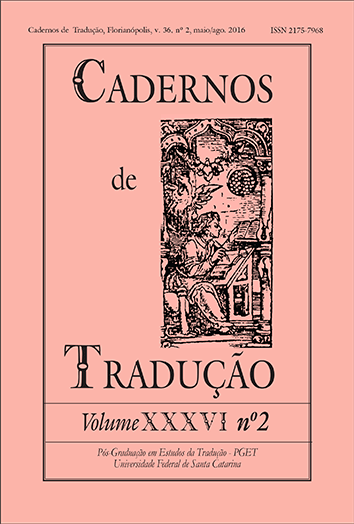What does it take to be a translator? : Macao (China) case study
DOI:
https://doi.org/10.5007/2175-7968.2016v36n2p180Resumen
This article aims to reflect on the teaching and the learning of translation between Portuguese and Chinese languages, in Macao, and the Macao Polytechnic Institute’s role in the training of translators, since 1991[1] to 2004. Since the arrival of the Portuguese, more than four centuries ago, translation is deemed an essential condition for the functioning of institutions and people’s social life. Intercultural and interlinguistic contacts between the Portuguese and Chinese languages, today official languages, have compelled to translation efforts and the training of translators has been an area of primordial research. Over one century of experience in teaching translation, it is critical to analyze the translation labor market from the perspective of the professionals themselves, allowing to identify its characteristics and to figure out the future prospects; such analysis is essential for the curriculum design of translation training programs in line with the translators needs. Before the research we made the following assumptions: (1) the number of translators available in the market is insufficient but, every year, more graduates come to the market; (2) the local market is seeking translators and interpreters who are able to translate any document in any field, in both directions; (3) Macao Public Administration is the largest employer of Chinese-Portuguese translators and also the preferred place to work as a translator; (4) there is a significant number of translators that opt for another career, such as law or assume other duties not related with their studies. The main focus of this research is the vision of the translation professionals, since it aimed to identify the aspects considered by the translators themselves as the most relevant, and which must be taken into account by the higher education institutions in the translation curriculum design.
[1] The public higher education in Macao was created in 1991.
Citas
AGUIAR, M. T. S. (2002). Tradução e Interpretação em Macau. Em: IPM. Workshop de Tradução e Interpretação no Novo Milénio. Macau: IPM, 31-62.
ALVES, J. M. (2003). A Administração Portuguesa de Macau e a Língua Chinesa: Relatório da Comissão para a Implementação da Língua Chinesa – Documentação Complementar – 1985-1986. Macau: Coord. e Edição de João C. Reis.
DRAGO, J. (2003, Agosto). Os novos desígnios do Ensino Superior. Revista Macau, III Series, 15, 52-70.
DUFF, A. (1989). Translation. Oxford: Oxford University Press.
EHRENBERG, R. G. e SMITH, R. S. (2008). Modern Labor Economics: Theory and Policy (10th Edition). Toronto: Addison Wesley.
LAJES, A. (06/02/09). Nada como Antigamente: Politécnico forma mais de 100 tradutores por ano. Jornal Hoje Macau. [Online], [Accessed on 07-02-2009]. Available at: www.hojemacau.com/news.phtml?id=32455&today=06022009
MAR, D. e NEVES, P. (2009, 16 de Março). Interview with Maria Antónia Espadinha: Interesse pela Língua Portuguesa tem crescido. Jornal Tribuna de Macau. [Online], [Accessed on 17-03-2009]. Available at: http://www.jtm.com.mo/view.asp?dT=309603001.
YU, H. (2006). O Papel da tradução chinês/português na Cooperação Económica e Comercial entre a China e os Países de Língua Portuguesa. Boletim Trimestral nº 3. Macau: Fórum para a Cooperação Económica e Comercial entre a China e os Países de Língua Portuguesa, 11-13.
Descargas
Publicado
Cómo citar
Número
Sección
Licencia
Declaración de Derecho de Autor
Los autores conservan sus derechos de autor y conceden a la revista el derecho a la primera publicación bajo la Licencia Creative Commons Attribution, que permite que se comparta el trabajo reconociéndose la autoría y publicación inicial en esta revista.
Los autores están autorizados a asumir contratos adicionales por separado para la distribución no exclusiva de la versión del trabajo publicada en esta revista (por ej.: publicar en un repositorio institucional o como capítulo de libro, reconociéndose la autoría y publicación inicial en esta revista).





















































